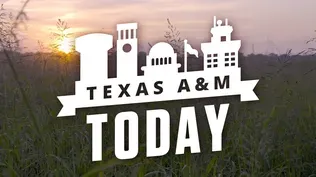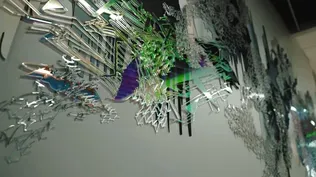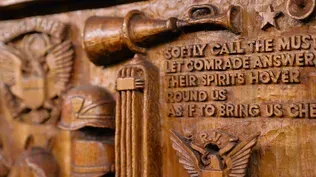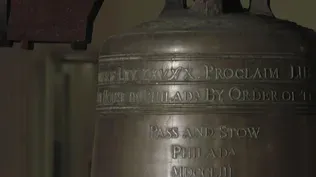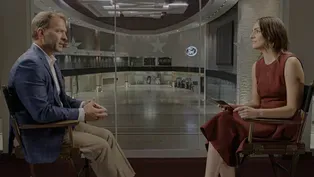
Ep. 1 - Art at Texas A&M
Season 1 Episode 1 | 28m 41sVideo has Closed Captions
Meet the people behind blown glass, woodcarvings and STEM-inspired art at Texas A&M.
On the premiere of “Texas A&M Today,” discover art at Texas A&M. Learn about the Department of Chemistry’s glass blower and how he combines art and science to keep vital research going. Find out how the famous MSC woodcarvings came to be in a first-hand account from Rodney Hill. Get a tour of the art collection in the state-of-the-art Zachry building. Plus, hear from Athletic Director Ross Bjork.
Problems with Closed Captions? Closed Captioning Feedback
Problems with Closed Captions? Closed Captioning Feedback
Texas A&M Today is a local public television program presented by KAMU

Ep. 1 - Art at Texas A&M
Season 1 Episode 1 | 28m 41sVideo has Closed Captions
On the premiere of “Texas A&M Today,” discover art at Texas A&M. Learn about the Department of Chemistry’s glass blower and how he combines art and science to keep vital research going. Find out how the famous MSC woodcarvings came to be in a first-hand account from Rodney Hill. Get a tour of the art collection in the state-of-the-art Zachry building. Plus, hear from Athletic Director Ross Bjork.
Problems with Closed Captions? Closed Captioning Feedback
How to Watch Texas A&M Today
Texas A&M Today is available to stream on pbs.org and the free PBS App, available on iPhone, Apple TV, Android TV, Android smartphones, Amazon Fire TV, Amazon Fire Tablet, Roku, Samsung Smart TV, and Vizio.
Providing Support for PBS.org
Learn Moreabout PBS online sponsorship- Howdy from Texas A&M.
- It's almost like an operation, like a doctor would do.
You're sweating Then your glasses have gotten clogged up.
- I had from noon till midnight to work every day for two years.
- I first took a look at what makes Texas A&M special.
And it's really obvious.
It's the comradery.
- Welcome to campus.
Welcome to Texas A&M Today.
Howdy!
I'm your host Chelsea Reber, at the Memorial Student Center, at Texas A&M University.
In the next six episodes, we'll shine a spotlight on the best and brightest of A&M.
Today, we'll take a tour of the multi-million dollar art collection inside the world-class Zachry building.
Plus we'll meet the beloved Professor who literally carved out Texas A&M's history.
And we learn the story behind an American artifact here on campus.
But let's begin with the man, our award-winning chemistry department says, is vital to their success.
Bill Merka, A&M's personal glass blower.
(uplifting music) - Art is conceptualizing.
Art is bringing it from your mind to your hand.
To be a glass blower, you have to be dedicated.
You play with the glass, you're just pushing it, seeing what it can do, seeing if this is possible.
Sometimes it is, sometimes it isn't.
We bridge two worlds here.
We kind of bridge a mechanical side and then you have to have an artistic flare.
You got to try to figure it out in your mind and then, with your hands and just your knowledge, make it happen.
- People come here, to Texas A&M University, to work in our department, because of the quality of the staff and the facilities that we have.
What makes our department really unique is that we have probably the largest undergraduate teaching program in the country.
We have just outstanding researchers here and a strong research reputation, and they will affect, I think, all sorts of things in our world.
There's a lot of eyes, looking at our department with a bit of envy.
The key in all this, is we're only as good as everyone in the department.
- Organic chemistry has a bigger impact on your life than you would think.
What we're doing is essentially, we're trying to change the way people think about doing science.
A master glass blower is essential to an organic chemistry lab and to a lot of other disciplines.
- It's imperative that we have here that, someone that can do the work.
Bill's fantastic at this.
He listens, and he works in a collaborative way with the faculty.
- Now right here.
It necks down to where it's slightly a smaller diameter where hopefully it'll fit.
To your average person, when they come to down to the glass shop and maybe they want to see what you do and they want to see you build something.
They sometimes are a little disappointed because what we do takes a long time.
We don't have a big giant vat of molten glass.
We mainly work with borosilicate.
Everybody knows it as Pyrex.
And we use Pyrex because of its chemical qualities, its clarity, and its heat resistance.
My old boss used to say, your best friend and your worst enemy is uncle Joe gravity.
Gravity is pulling down on the glass and centrifugal force is working on the glass.
All these physical things are working on the glass.
So you're actually using your breath to hold it out.
Or if you want to blow a bulb in it, you actually use your breath to do it.
You're just barely putting a little pressure on the inside and you need to have finite control and your lungs are the best finite control there is.
- Glass blowers are hard to find these days.
That is one of the things that helped attract me to come here is to have the resources that Texas A&M provides, and having a master glass blower in the basement, that's here every day to help develop our glassware.
- We're a custom shop.
At a lot of universities they're not there and we're still here.
Our shop does not make beakers, and test tubes, and flasks.
We start with tubes, and rods, and joints, and kind of parts.
Then we blow 'em out, and poke holes in 'em, and blow holes in 'em, and weld things on, and form them.
And it's all done by hand.
If you need a flask, inside of a flask, inside of a flask.
We can do it a lot cheaper, and just as well, if not better.
- You often don't know what you actually need.
And Bill can, he knows what you need.
And he knows what can be made.
And that's really hard to find.
- We really like being part of this community of scientists.
I am not a chemist, but I learn what I need to know about individual projects and just general chemistry, to be able to know what the researchers are talking about.
- The creation of really, state of the art pieces involves this interaction, and this back and forth that you miss, when you mail something to someone, and receive it back in the mail.
- It's almost like an operation, like a doctor would do.
You're sweating and then your glasses have gotten clogged up with sweat.
It can be intense.
It's a hot job.
Like you would think a glass shop would be.
- It takes a long time to get to a stage where you can do the sort of things that Bill can do.
There's a technical skill, but there's also, you know, there's this, this wealth of experience, he's had to make just about everything.
- This will be my 38th year in the glass shop.
Other people call me an artist.
I don't necessarily consider myself some kind of Rembrandt or anything like that.
I consider myself more of a mechanic, not as many glass blowers out there too.
It's maybe kind of a dying art.
- Bill is amazing at getting programs up and running.
And that rapid feedback allows us to be as productive as we are and allows us to move science forward, at the pace we want.
We're convinced that something will make a huge difference and, we hope change the world in a positive way.
- Between new pieces and repairs, Bill Merka says, he works on more than 1000 pieces a year.
And he isn't the only example of art intersecting, with science at A&M.
When the new Zachry Engineering Education Complex was built, 10 artists were selected from more than a hundred candidates to create pieces inspired by science, technology, engineering, and math.
As you'll soon be able to tell, the possibilities were limitless.
(uplifting music) - In late 2015, we were approached by the then Dean of the College of Engineering, Katherine Banks.
She really believed, in what I, what really struck me as being revolutionary, is that there is this parallel, that can be drawn between the mindset of an artist innovator, and engineers, and mathematicians, and scientists.
And in several conversations, we started to unpack a bit of what her mission and her goal was with regards to amassing a collection of art, specifically for the College of Engineering.
- The caliber of artists who are behind the works that are here in the building are top notch.
And I think it speaks to the rise of the College of Engineering, that we see the rise in the rankings, the quality of our faculty, the quality of our students.
I think it, it's all part of the trajectory that we are on.
And we're very proud to be able to partner with those artists.
- It is a collection of great diversity, in terms of the types of artists.
The types of works.
It's a collection of works created by international artists, as well as artists that are in Texas.
We really tried to make sure that we were receptive to looking beyond just the parameters of the state lines.
I do think it's a very special group of artists.
And I think that it makes the program here, at the College of Engineering that much more unique and special.
(uplifting music) - I got notified that they were taking a look at my work, for Texas A&M for the Zachry building.
And it, you know, initially you did, you know, it's like, wow, that's cool.
And I, part of me was like, are you guys sure.
You know, and I mean, I get it.
I make data art and it's, you know, and it fits in that world and that environment.
And I was really excited to be part of it.
I think there's a, there's a kinship between art and technology, art and science.
And, you know, initially I wanted something that created sort of a warmth and a humanness.
And so I started looking for what kind of data can I get about the students that was this kind of intuitive connection to the work that people do in that very building.
- Many of the artists are very interested in pushing materials into a technologic perspective.
We've got video works that are here.
We've got mechanic works that are here as well.
Baseline, they all needed to depart from some influence, conceptually from a STEM influence or level of interest from the artists.
- You see approximation, you see refinement.
And I think it's really important for students to see the different visualizations that can inspire them to think about how they might visualize their solutions in engineering problems.
We have a piece on the first floor that is painting, but then there's light shown on it.
And so you get this interplay between static and dynamic, because the light changes, we see that in engineering.
There's a huge piece that hangs, I think, off of the fourth floor, that's an engineering marvel, that it was brought into this building, in pieces and assembled.
The smoothness that you see from afar is incredible.
But when you get up close, you'll notice, that it's in aluminum foil, that is pressed to it, adhered to it.
And it's a little bit fractal in that way.
And then of course, the large piece, out behind me in the engineering quad.
You'll see two pieces, you'll see a simple cube.
And then across the lawn, you see a large sphere and that's to show how a simple cube being replicated many times, can come to approximate a large sphere.
And if you went ad infinitum, you would get there.
- What ends up happening is that students and professors and general public who meanders through the halls, stumbles upon the works of art, and starts with a question, why?
And at that point then continues on that, investigative conversation that they can have about, how art comes to be?
- What I hope students take away, is this really simple idea, that the data about them, about them individually, personally, could start to have meaning.
I mean, it could be 10 years, 20 years, 30 years, you know, they're, you know, they're these CEOs, you know, that are running companies and they'll go, you know, that's crazy.
There was a piece like this, you know, at Texas A&M that started to look at data and that these patterns could come back to you and give a sense of self, and a sense of individuality.
And, it was a little glimpse into the future.
- Each piece was privately-funded, with some artists traveling from Spain, Germany, and South Africa to install their pieces.
(drumbeats) It's time for an Aggie Fact.
Did you know, there used to be a light on top of the Academic Building.
Prexy's Moon lit the way for students at night, Prexy being slang for the President of the college.
It was removed more than 90 years ago.
Why?
After World War I, many Aggie cadets still carried live ammunition around campus, and the lamp was used for target practice.
When weekend shooting contests became the norm, administrators took the light down, in 1931.
Today, it's still on campus, stored inside Cushing Memorial library.
We've stepped from the Flag Room at the MSC, out to the hallway, where this beautiful piece of artwork, guides us through Texas A&M's history.
Six wood panels, all lovingly carved by a couple who weren't Aggies when they got here, but are now cherished members of the Aggie family.
- It's a chance to look back and reflect at what the University was like.
It's also a chance to imagine what the University could be going forward.
They really do capture the history of Texas A&M, the history of the country actually.
I mean, you see things on there that don't even exist anymore because these were made so much earlier, like, early computer chips and things that we take for granted today, that were new and innovative at the time he did the woodcarvings.
- Some of the Houston carvings and Dallas ones I did, gave me the most confidence.
Then the Highland Park Methodist Church, which was as extensive as the MSC ones.
I would spend every waking hour in the studio carving on them, which gave me the ease to get into the A&M panels, 'cause the A&M panels were so intricate.
So many things had to be carved, lettering wise and everything, that you had to know how the wood's going to act.
You know, a lot of the lettering, used really thin chisels, so that you're not breaking off big pieces and creating gashes and stuff where you don't want 'em.
If I had a choice, I probably would've gone to art school.
My dad was an artist, and so was my mother.
And they were definitely against it.
So I went into architecture school.
When I got back here, you know, all the students assumed, I was this wild person, you know, from Berkeley, and not from Lubbock.
We closed the deal without anybody in the neighborhood seeing us, you know, at the bank.
And then we parked our yellow van in the driveway and it was, you know, past Presidents and department heads peering out their blinds in horror, as I got out in my bell bottoms and mutton chops.
I met with the Board of Regents.
And then they said they wanted a history of A&M, but there was no history of A&M.
- He'd come home.
He'd say, did you know A&M did this, and this, and this?
Every day, something new and wonderful.
'Cause he interviewed everybody.
The Deans on down to the, all the retired Professors, anybody who was involved in anything that was significant.
- It wasn't 'cause I wasn't a historian, but you know, somebody had to do it and nobody was doing it.
So I just did it.
- Other than the archives that are held at Cushing Library, I would say that this is the most accessible way for anybody, particularly if you're literate or not literate, it's easy to read the history of Texas A&M through these panels.
- Any kind of artwork or anything like that, we'll do together.
- We would stay up late and he'd say just do the stuff that's drone work when you're tired.
And so you didn't have to really think, so you could do that into the wee hours of the morning, but when you had to think you had to be awake.
So we'd wait and do the problems in the morning or during the day.
- I had from noon till midnight, to work, every day for two years.
- The quality of the wood that he used, is very interesting because part of what I do, is take care of all of the public art on campus and having to clean every little nook and crevice on those wood panels really makes you appreciate the difficulty and the length of time that Rodney and Sue devoted to creating these pieces.
- You want a hardwood if you're trying to do detail, 'cause it's not going to sparce or bleed.
And walnut seemed to be a really good one.
The A&M panels, I used all 80 different tools.
There were dent gauges, spoon gauges, then regular chisels, and you've got to get all different widths and sizes.
And then you use wooden mallets, that you hit them with.
And I have probably, three or four different sizes of mallets out there that I use.
On that first panel, you'll see, there are little clusters of blackberries around some of the buildings.
This place used to be covered with wild berries.
One of the years, they had yell leaders wearing cowboy outfits, with megaphones and cowboy hats and stuff.
Seeing all these different things, then you try to put it together.
Same with Reveille, from the first Reveille onto the present.
The uniforms on the core panel, a lot of the archives, I got those from their annuals and occasionally I would get photographs of yell leaders and the football players and we'd use from those photographs.
We would copy as best we could.
You know, those faces.
- I think everybody that looks at that, goes, gee, that's amazing.
The alumni that come back remember what it was like when they were at A&M.
The students that look at them now, go, I can't believe it was like that back then.
And future students have an opportunity to see themselves, as their growth in their college career.
- 30 Years from now, everything's going to be different.
10 years from now, everything's going to be different.
But you know, I'm glad, that people see it and think that's their era.
You know, that's when they were here and they feel that, and that makes me feel real good.
- Professor Hill recently retired from A&M after teaching for more than 50 years.
His legacy isn't going anywhere, thanks to these panels and the thousands of students he impacted.
Speaking of A&M history, we've got a story that may ring a bell.
Here's how Texas A&M became the only public university with this iconic artifact, that embodies American patriotism.
In the late 1800's and early 1900's, the Liberty Bell made seven trips to events across the country.
Its last and biggest trip came in 1915.
Packed in a specially-cushioned rail car, the bell made 275 stops in 30 states, including Bryan and College Station.
300 people waited out a six-hour delay to touch the bell in the middle of the night.
During the tour, nearly a quarter of the nation's population flocked to see and touch the famous bell.
And when the US entered World War I less than two years later, the country's leaders knew what to do.
Strapped for cash, the Department of the Treasury put the Liberty Bell at the center of four war bond campaigns.
The patriotism worked.
The campaigns raised $17 billion, equivalent to nearly $425 billion today.
Fast forward to 1950, World War II was over, the Cold War was beginning and once more, the nation needed money.
So the Liberty Bell was put to use again, with a new twist.
A foundry in France was commissioned to cast more than 50 full size replicas of the bell.
They toured the country easily exceeding the $650 million goal before being gifted to each state and territory.
Most of the replicas are housed in their state's capitals, with a few exceptions.
Texas Governor, Allan Shivers, chose A&M for the Texas bell's home, because of the patriotism the school displayed during World War II.
He said no one suffered more than the Aggies, after more than 20,000 fought in the war, with 953 dying to protect our freedom.
Today the bell remains on display in A&M's Academic Building, inspiring people to look up and stay united.
The bell has only been rung a handful of times, each as a special reminder of the sacrifices made for past, present, and future Aggies.
Next, I caught up with a Texas A&M difference maker for a one-on-one conversation.
Today that's Athletic Director, Ross Bjork.
Ross came to Texas A&M in 2019, after spending seven years as the AD at Ole Miss.
He oversees 20 varsity sports and more than 650 student athletes.
Conference realignment is not stopping, nor slowing down.
Where do you see the future of realignment?
- You know, it's really a, it's a fascinating time in our business when it comes to this, 'cause it feels like, it's about branding.
It's about exposure.
It's obviously about the money, you know, the answer's money, Now what's the question?
a lot of times is what happens in our industry.
And so the dynamics of all of that are playing out in real time.
Obviously we went through conference realignment last summer.
We don't necessarily like how it happened here at A&M, and within the SEC, but we understand why?
- Well now, we'll get to the hot topic of NIL.
It is one of the most talked about topics in college athletics right now.
A&M has a program called AMPLIFY to help students in this new realm.
Can you tell me more about AMPLIFY?
- So AMPLIFY is really about awareness, education, monitoring.
The athletes have to turn their contracts into compliance.
They can do all that through our AMPLIFY app.
What's really next is, where does all this go?
That's what everybody's trying to figure out is we're a year into it.
What does the next year look like?
What do the next five years look like?
I don't necessarily have that crystal ball, but it's here to stay.
We embrace it.
We want our athletes to kind of achieve their maximum potential, whatever that is, whether that's on the field or whether that's NIL or whether that's academically.
We have to embrace all of this.
Our donors have embraced it.
Our staff has embraced it.
The issue with how the law is set up is we can't be involved in facilitating.
That's kind of the tough part about this, is each state has different laws.
So really what's next is uniformity nationwide.
So we may need Congress for that.
We may need Federal legislation for that, but those are the things that we're tracking as we monitor NIL a year into the program.
- You are a very busy man.
We've talked a little bit about this before, just your schedule and how insane it can get.
What does Ross Bjork do on a day off?
- I would say the first thing is I'm a family person.
So if I'm not working around Texas A&M, I'm at a kid's soccer game, a basketball game, a football scrimmage, a seven on seven, a football camp, A&M Consolidated is my second, maybe my favorite team, besides the Aggies, 'cause that's where my son will play this fall.
So I'm going to be around family.
I love to work out.
I love to study college sports.
So I'm reading a lot.
- What excites you about the future of Aggie sports?
- Having common shared vision about what can happen here, to me creates the excitement.
Our job is to execute on that, but you've got to have the right people.
You've got to have the right coaches.
You've got to have the right resources.
So we're selling a ton of football season tickets, which helps the revenue stream.
We're raising money in a capital campaign, the Centennial campaign, and we're breaking ground as we speak on our athletic facilities.
We have these new coaches that are infusing this new energy.
We're recruiting at a high level.
A&M should win SEC championships.
That's our expectation.
We're not there yet, we got work to do.
We need to be back in the top 10 in the Director's Cup and all those kind of things.
So there's work to be done, but the pieces are in place and now hopefully we can maximize those and put everything together.
- All right, great.
You can watch an extended version of this interview on our website.
Ross, thank you so much.
- Thank you so much, Chelsea.
- Thanks for watching the premiere of Texas A&M today.
We hope you'll join us again in two weeks, as we learn about more people making a difference at Texas A&M.
(uplifting music)
Extended Cut: Ross Bjork Interview
Video has Closed Captions
Watch Chelsea Reber’s full-length interview with Texas A&M Athletic Director Ross Bjork. (28m 46s)
Providing Support for PBS.org
Learn Moreabout PBS online sponsorshipSupport for PBS provided by:
Texas A&M Today is a local public television program presented by KAMU
